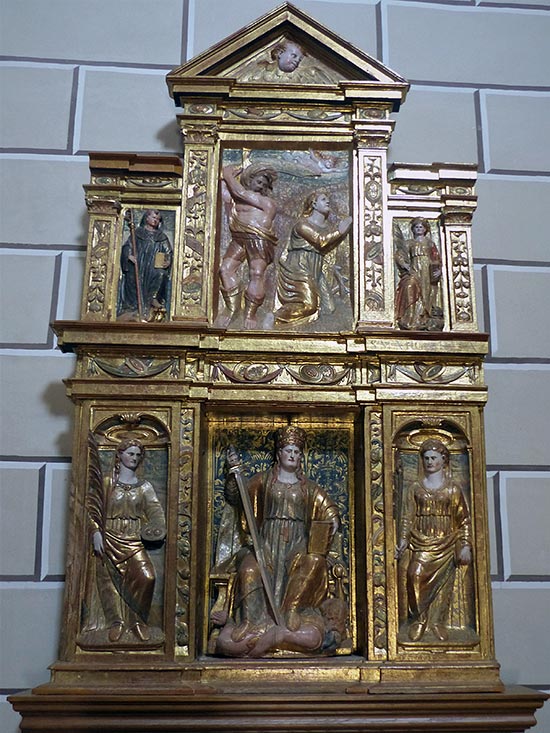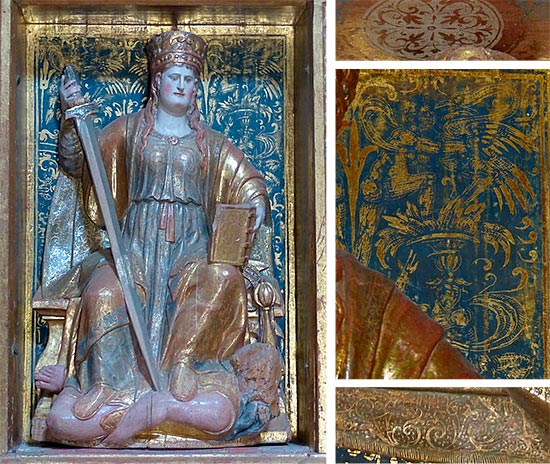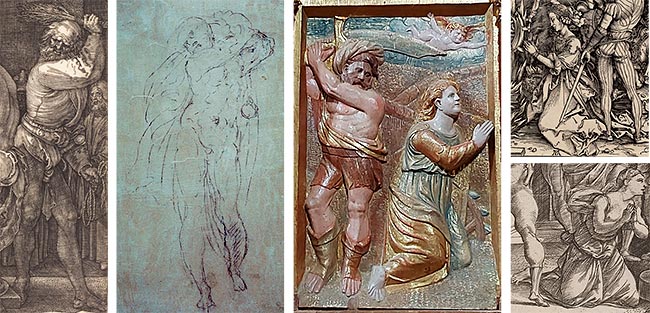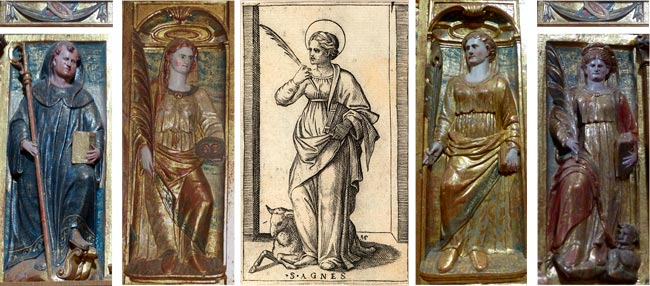The piece of the month of July 2022
THE RENAISSANCE ALTARPIECE OF SANTA CATALINA DE ENÉRIZ, WORK OF THE SCULPTOR JUAN DE OBERÓN
Pedro Luis Echeverría Goñi
University of the Basque Country
Among the furnishings of the Magdalena de Enériz parish church is the small Renaissance altarpiece of Santa Catalina, which belonged to the previous Romanesque church and later presided over the Shrine of Our Lady of Fair Love of her dedication annexed to the cemetery. Restored in 1997, it is placed today on the wall of the gospel side in front of the main door. About its authorship, we only know that Juan de Arbizu, neighbor of Puente la Reina, ceded in 1567 to master Juan de Oberón, imaginer, half of the lease of the Enériz first fruits for three years at the rate of 55 ducats per year, undoubtedly to guarantee the collection of the amount of this altar. The altarpiece retains its original polychromy with burnished gilding and beautiful sgraffito grotesques on the panel of the background of the patron, which we can attribute to Juan de Larequi(c. 1532-1583), an outstanding painter from Pamplona, according to Oberón himself, who in 1569 presented him as his guarantor in the aforementioned deed.
Son of the French carver Guillén de Oberon († 1563), neighbor of Puente la Reina, Juan de Oberon (1531- c. 1578) was a Renaissance carver who executed not only walnut carvings and whip works, but also statues and stone shields, for which he received a higher salary. In 1559 he worked under the orders of Martín de Mazquiarán, a stonemason from Cegama, on the statues of the primitive façade of the parish of Mendigorría, of which the statues of St. Peter, St. Paul and St. Andrew are preserved in the present-day church. He was trained in the family workshop, first collaborating in his father's companies and, as a journeyman, he worked for carvers from Puente la Reina such as Juan de Iturmendi and Juan de Irisarri, and from Pamplona such as Pedro de Contreras. He is the author of expressive pieces such as the Virgen del Rosario and San Miguel de Artazu, perceiving in some, such as the reliefs of the Enériz altarpiece, certain features that anticipate Romanism.

Enériz. Parish church. Altarpiece of Santa Catalina.
The small altarpiece of Santa Catalina is a Mannerist ensemble consisting of two sections, three streets and an attic topped by a triangular pediment with an angel's head. The recessed pilasters are decorated with strings of trophies, ribbons, cards and fruits, while the friezes are linked by hanging fabrics with crossed shields. The protagonism of the titular saint is reflected in the only carving of the saint and, above it, the story of her decapitation, both on a larger scale than the rest. The side streets are flanked by the high reliefs of St. Lucy, St. Apollonia, St. Benedict and St. Margaret, the last two of smaller size, which are identified by inscriptions with their names in capital letters.
It houses the images of five virgins martyrs, very popular since the Age average, in a association that is repeated in other Navarrese altarpieces such as the major one of Aróstegui or the collateral one of Santa Catalina de Ochagavía. Their legendary stories come from the Golden Legend of Santiago de la Vorágine and, although different, they have several points of coincidence. Almost all of them belonged to noble families and, converted to Christianity, suffered terrible martyrdoms, defending their faith and virginity, from which they miraculously emerged alive to finally die beheaded, in accordance with their rank.

Carving of Santa Catalina. Sgraffito details with grotesques and moresques.
The majestic carving of St. Catherine of Alexandria enthroned and crowned, with the emperor Maxentius at her feet, presides over the altarpiece. She holds in her right hand the sword of her martyrdom, which she crosses diagonally, and in the other hand she carries a book Closed, symbol of wisdom. This outline reminds us of the late Gothic panel of St. Catherine, head of the altarpiece in the chapel of the Rosary in the church of San Pablo in Zaragoza, with the logical stylistic differences. Another carving of St. Catherine standing upright with her hand is preserved in the church of San Saturnino de Artajona, with similar characteristics, which was valued in 1562 by Roberto Carlit at eight ducats. After Mary, she is the woman most represented in all the arts and is part of the group of the "Four Capital Virgins", together with Saint Margaret, who also appears in this altarpiece. In Navarre, churches such as Muniáin (Guesálaz), hermitages such as the one in Azcona, almost fifty altarpieces and brotherhoods established in Pamplona, Tafalla and Sangüesa bear this dedication.

Photomontage of the beheading of St. Catherine. A. Dürer. Sayon of a flagellation. Michelangelo. Slave. Secret Chamber of the Medici Chapel. Dürer and D. Campagnola. Martyrdoms of St. Catherine.
The only scene of this altarpiece is the beheading of St. Catherine, which is represented in high relief in the attic above the title. This composition, already found in late Gothic German and Early Renaissance woodcuts, shows sample the saint kneeling in a prayerful attitude with the cogwheel, and the executioner behind at the moment of download his cutlass. The executioner dresses the Moorish woman with a turban, breeches and leggings, as a reflection of the general hostility towards these false converts. Against a background of landscape with linear planes of depth, the expressiveness of the saint contrasts with the rigidity and verticality of the sayón, while an angel with open arms flutters in the sky. The arrangement of the saint can be seen in engravings such as the one by Dürer, from 1496-1497, but for its tension and dynamism it is closer to the one made by the Venetian Domenico Campagnola in 1517. The executioner who is going to slit the saint's throat reminds us in this action, but not in the movement, of a slave drawn in charcoal by Michelangelo in 1530 in the chamber of the Medici Chapel in Florence, which coincides in its pose with that of the Apollo-David of the Florentine master.
Saint Catherine is flanked by the virgins Lucia and Apollonia, forming one of the most repeated feminine trilogies in Renaissance altarpieces. Being a privileged association , the relief of Saint Lucy of Syracuse is placed to the right of the titular, since she is one of the seven included in the canon of the Mass. Her characteristic attributes are the tray with her eyes that she holds in her left hand, as healer of sight problems, and the palm of martyrdom. On the left, St. Apollonia of Alexandria is depicted as a young woman, although the Golden Legend describes her as an old woman. She was invoked for toothache and other oral diseases, since in her martyrdom all her teeth were pulled out with blacksmith's tongs, which she holds as her attribute. Her outline comes from the engraving of St. Agnes by Marcantonio Raimondi from the series of the "Little Saints" (c. 1520), from which she takes the three-quarter length, the turn of the face to her right, the contraposto, the left arm with which she holds the book and the garments of her clothing. The main variation is the substitution of the palm that Agnes carries for the tongs of the martyrdom of Saint Apollonia.

Photomontage with St. Benedict, St. Lucy, St. Apollonia and St. Margaret. M. Raimondi. Saint Agnes.
The relief of Saint Benedict of Nursia responds to the Renaissance iconography after the reform of the Congregation of Valladolid, that is to say, as a young beardless man with wide tonsure. His characteristic black habit of the Order is composed of a talar tunic with a loose-fitting hood or cowl and wide sleeves. His attributes as founder are the book of the Holy Rule Closed, which he clutches in his left hand, and the abbot's crozier with a flowered scroll, symbol of his pastoral authority, which he holds firmly. He adopts a frontal disposition, although he turns his face to his left in virtue of the law of correspondence and rests his right foot on a footstool with double volute. To the left of the decapitation we see the relief of St. Margaret of Antioch, who appears as a young woman with a princess crown, a high-waisted dress, girdle and mantle that turns over the left knee. Her specific attribute is the anthropomorphic devil twisted at her feet, which she holds fastened with a chain, while she carries in her right hand the palm of martyrdom and in the left, a devotional book. Pregnant women invoked him to have a good childbirth.
This altarpiece is enhanced by a beautiful polychrome of fantastic Mannerism with generous burnished and silver gilding on the sword, cutlass and tongs. Among the sgraffito work we can see backgrounds with slashes and gouaches, concentrating the highest quality grotesques in the azurite background of St. Catherine's box. A psychomachy or struggle of antagonists between a naked boy with detailed anatomical study and a fantastic bird to prevent him from approaching a vase full of fruits of virtue is represented in series. In the borders of the mantles of the three saints of the first body, and especially on the back of the one of the titular saint, moresques are simulated that copy embroidery patterns and ornaments similar to those of F. Pellegrino (1530) or J. A. du Cerceau (1545).
SOURCES AND BIBLIOGRAPHY
file General of Navarra. Proceedings. Sign. 325869.
ECHEVERRÍA GOÑI, P. L., "Contribución del taller de Puente la Reina a la imaginería del siglo XVI", Príncipe de Viana, Anejo 11 (1988), pp. 97-108.
